The Burden of Cardiovascular Disease in West Virginia
Credits
Summary
Chapter 1
Chapter 2
Chapter 3
Chapter 4
Chapter 5
Chapter 6
References
Appendix A
Appendix B
Appendix C
Appendix D
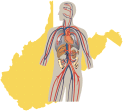 Chapter Four
Chapter Four
Cardiovascular Disease Mortality
Heart Disease Mortality | Stroke Mortaility
In 1998, there were 8,088 cardiovascular disease deaths among West Virginia
residents, 6,839 due to heart disease and 1,249 to cerebrovascular disease,
or stroke. Heart disease and stroke together accounted for 39.0% of total
deaths in the state in that year. Forty-one percent (40.7%) of deaths
among women were due to cardiovascular disease, compared to 37.1% of deaths
among men. Nationwide, heart disease and stroke were responsible of 37.7%
of all deaths in 1998.
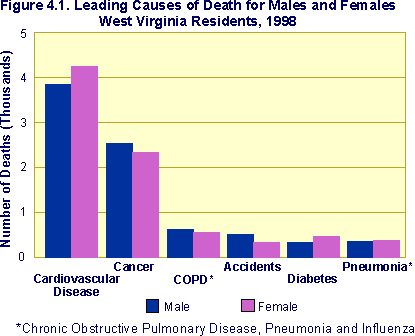
Heart Disease Mortality. Looking at heart disease mortality alone, the state's1998 age-adjusted rate of 328.9 deaths per 100,000 population was 21% higher than the U.S. age-adjusted rate of 272.5. West Virginia's rate was the second highest among all 50 states and the District of Columbia, with only Mississippi reporting a higher rate (366.8). (See Appendix C for individual state rates for 1998.) As depicted in Figure 4.2, heart disease mortality has been declining in both the state and the nation since the early 1970s; however, the gap between the two has remained relatively unchanged. In 1970, the U.S. rate of heart disease mortality was 493.1, compared to a West Virginia rate of 512.4. Since then, the West Virginia rate has declined at an annual average of 1.4%, while the U.S. rate has declined at approximately 1.5% per year. (Appendix C contains the state and national rates for individual years from 1970-98 for both genders.)
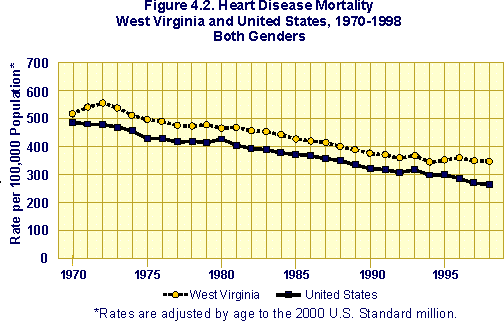
Male Heart Disease Mortality. Heart disease is the leading cause of death among male West Virginians over the age of 35. The 1998 state rate of 406.8 deaths per 100,000 males was 21% higher than the U.S. rate of 336.6. Figure 4.3 illustrates the declines in national and state heart disease mortality rates among men since 1970. There was an average decline in heart disease mortality among state men of 1.5% per year from 1970-98; in the U.S., the average annual decline was 1.6%.
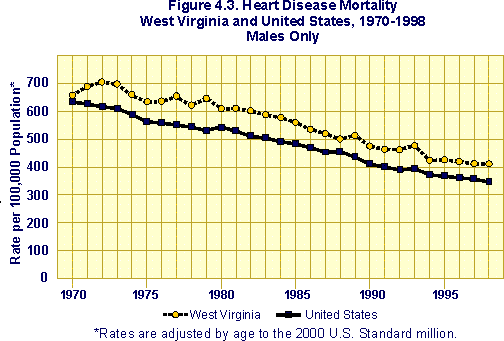
Female Heart Disease Mortality. While heart disease is the overall
killer for both sexes, it is primarily a disease of aging among women.
It is not the leading cause of death until age 75 and older for women,
but at those ages it far exceeds any other cause. In 1998, the rate among
West Virginia women was 268.4, 20% higher than the rate of 223.1 for all
U.S. women. From 1970 through 1998, the rate among state women decreased
at an average of 1.3% per year, a slightly smaller decline than among
men; the U.S. rate for women decreased 1.4% per year (Fig. 4.4).
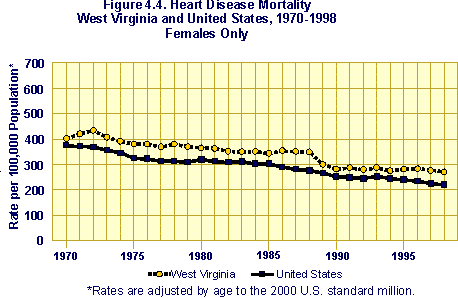
Minority Heart Disease Mortality. In the West Virginia Minority Health Chart Book, a study released in 1999 by the Bureau for Public Health, it was reported that from 1986 through 1995 African American residents had a mortality rate from heart disease that was 15% higher than that among white residents (32). The age-adjusted heart disease rate among African Americans was 396.6 per 100,000 compared to a rate of 343.9 among Caucasians. The average age at death from heart disease among men during that time period was similar for Caucasians and African Americans, 72.3 and 72.1, respectively. A greater difference was found between Caucasian and African American women. The average age of death from heart disease for Caucasian women was 79.7; among African American women it was 77.1.
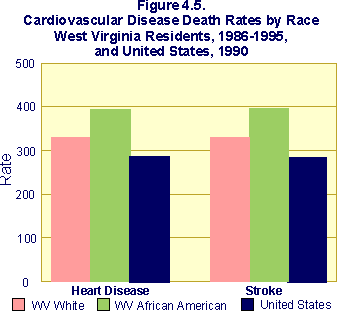
The same study reported a marked disparity between African American and
Caucasian heart disease mortality in terms of premature deaths. The rate
of years of potential life lost before age 65 (YPLL) for heart disease
was 58% higher among African Americans than among Caucasians, 1,327.6
per 100,000 population compared to 842.0.
County Heart Disease Mortality. Figure 4.6 presents crude heart disease mortality rates by county, using a five-year (1994-98) average. The overall crude rate for the state was 376.9 deaths per 100,000; Ritchie County had the highest average rate (526.2) while Monongalia County had the lowest average rate (227.1). Appendix C contains individual county rates for the five-year period.
Popup Map of Heart Disease Mortality Rates by county.
Heart Disease Mortality and Healthy People 2010. Heart disease mortality is addressed in one of the objectives set forth in West Virginia Healthy People 2010, a statewide initiative that will serve as a guide for improving the health of our residents over the next decade. Objective 12.1 reads "Reduce heart disease mortality to no more than 200 deaths per 100,000 population" (24). If this objective is accomplished, approximately 2,400 lives per year would be saved.
Stroke Mortality. West Virginia's 1998 age-adjusted rate of stroke mortality was 60.3 deaths per 100,000 population, slightly higher than the national rate of 59.6. Although strokes can occur at any age, cerebrovascular disease primarily affects the elderly, with stroke being the third leading cause of death for individuals over the age of 75. The rate of stroke death has decreased markedly over the past three decades, an average of 2.2% per year in both the state and the nation.
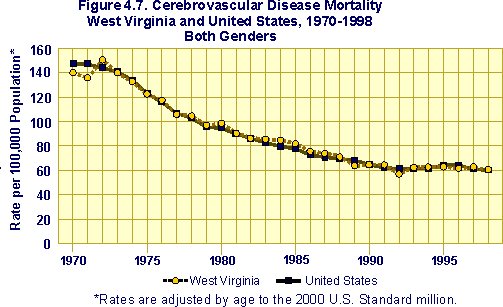
Male Stroke Mortality. In 1998, the age-adjusted rate of stroke
mortality among West Virginia men was 62.9 deaths per 100,000 male population,
slightly higher than the national rate of 60.1 among men. The state rate
of male stroke mortality declined at an average rate of 2.3% annually
from 1970 through 1998, compared to an annual average decline of 2.2%
nationwide (Fig. 4.8).
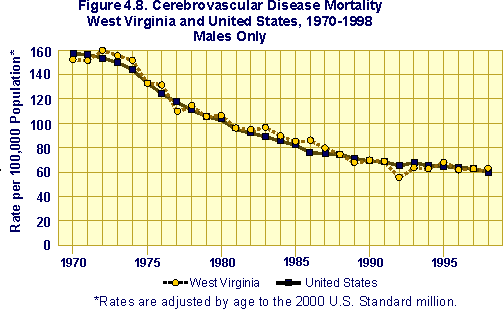
Female Stroke Mortality. The 1998 state and national rates of stroke
mortality among women were similar, 58.9 and 58.3 deaths per 100,000 female
population, respectively. During the period 1970-98, deaths from stroke
among West Virginia women decreased an average of 1.3% annually; the nation
experienced an average annual decline of 1.4% in female stroke mortality
(Fig. 4.9).
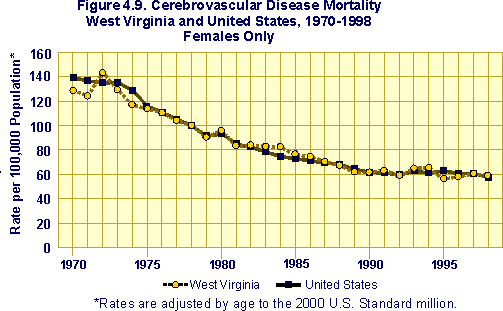
Minority Stroke Mortality. As reported in the 1999 West Virginia Minority Health Chart Book, stroke mortality from 1986-95 was 28% higher among African American West Virginians than among Caucasians, a rate of 75.5 deaths per 100,000 population compared to 59.2 (Fig. 4.5). The average age at death from stroke was lower among both African American men (73.2) and women (78.9) than among their white counterparts, 76.1 and 80.2, respectively. The YPLL rate for stroke was 184% higher among African Americans than among Caucasians, 277.8 YPLL per 100,000 population compared to 97.6.
County Stroke Mortality. Figure 4.10 presents cerebrovascular disease mortality rates by county, using data averaged from 1994 through 1998. The overall crude rate for the state for that period was 68.7 deaths per 100,000 population. Ohio County reported the highest rate at 108.7; Mingo County had the lowest rate at 35.2. Individual county rates are listed in Appendix C.
Popup Map of Map showing cerebrovascular disease mortality by county.
Stroke Mortality and Healthy People 2010. Objective 12.2 in West Virginia Healthy People 2010 reads "Reduce stroke deaths to no more than 45 per 100,000 population" (24). If this is accomplished, it would represent a 25% decrease over 1998, representing an annual saving of approximately 320 lives. Cardiovascular Disease as a Contributing Cause of Death. A review of the 1998 multiple-cause-of-death data set available from the National Center for Health Statistics showed that, even when cardiovascular disease is not the principal, or underlying, cause of death, it is frequently listed as a contributing cause on the death certificate, indicating the deceased had at some time received such a diagnosis. Up to 20 contributing causes of death may be listed on the death certificate. In 1998, two-thirds, or 67.2%, of all West Virginia death certificates had CVD listed as either the underlying or a contributing cause of death. In the U. S. as a whole, 61.5% of certificates had some form of CVD as either underlying or contributing cause of death. (See Appendix C for a listing of the most frequently listed causes of death, both underlying and contributing, in both West Virginia and the United States.)
Heart Disease. Heart disease is the most frequently listed cause of death in the state. According to the 1998 multiple-cause-of-death database, twenty-two percent (21.8%) of all death certificates recorded in West Virginia in that year had heart disease as a contributing cause of death. Added to the 33.2% of death certificates on the database listing heart disease as the principal cause, 55.0% of all deaths in West Virginia in 1998 were associated to some degree with heart disease. Figure 4.11 illustrates the proportion of all West Virginia deaths in 1998 that had heart disease listed as either the principal or contributing cause of death.
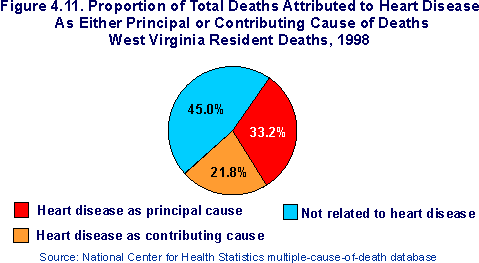
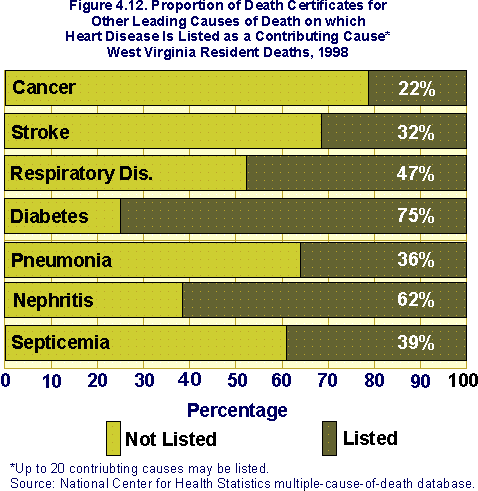 Of
the nine leading causes of death following heart disease in 1998, seven
had heart disease listed as a contributing cause on at least 20% of the
death certificates. Figure 4.12 presents the proportion of each of theses
causes in which heart disease was listed as a contributing cause. Three
out of every four (75.0%) death certificates on which diabetes was the
principal cause of death listed heart disease as a contributing cause.
Overall, West Virginia was third among all 50 states and the District
of Columbia when states were ranked according to the rate at which heart
disease was listed as a contributing cause on a death certificate in 1998.
Of
the nine leading causes of death following heart disease in 1998, seven
had heart disease listed as a contributing cause on at least 20% of the
death certificates. Figure 4.12 presents the proportion of each of theses
causes in which heart disease was listed as a contributing cause. Three
out of every four (75.0%) death certificates on which diabetes was the
principal cause of death listed heart disease as a contributing cause.
Overall, West Virginia was third among all 50 states and the District
of Columbia when states were ranked according to the rate at which heart
disease was listed as a contributing cause on a death certificate in 1998.
Stroke. Stroke as an underlying cause of death accounted for 6.0% of all deaths in West Virginia in 1998. In addition, 6.4% of death certificates listed cerebrovascular disease as a contributing cause of death. Cerebrovascular disease was listed as a contributing cause on 11.2% of death certificates on which pneumonia and influenza was the underlying cause and for 7.7% of deaths due to septicemia. West Virginia was first among all 50 states and the District of Columbia when ranked according to the rate at which cerebrovascular disease was listed as a contributing cause of death in 1998.